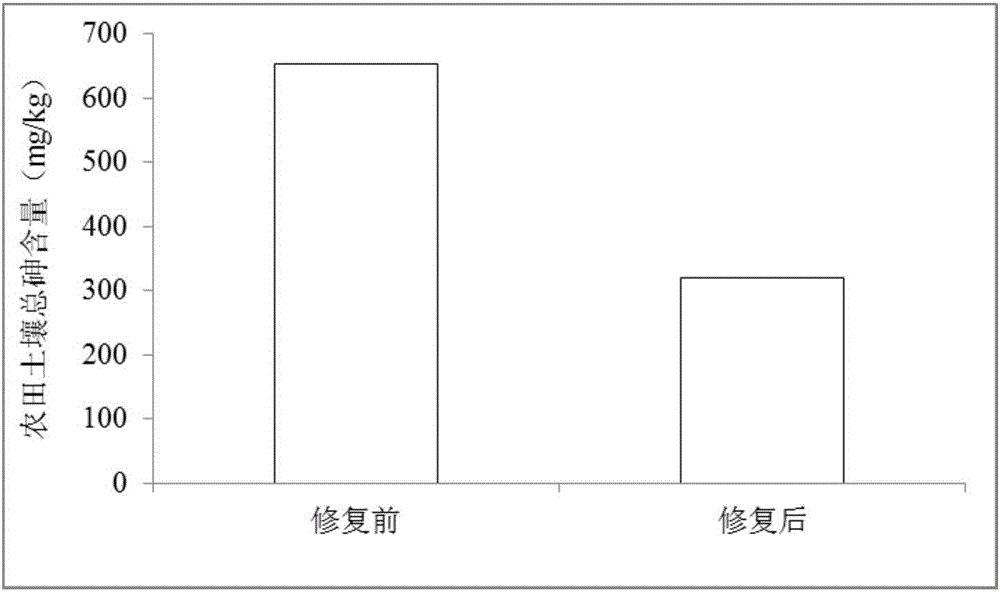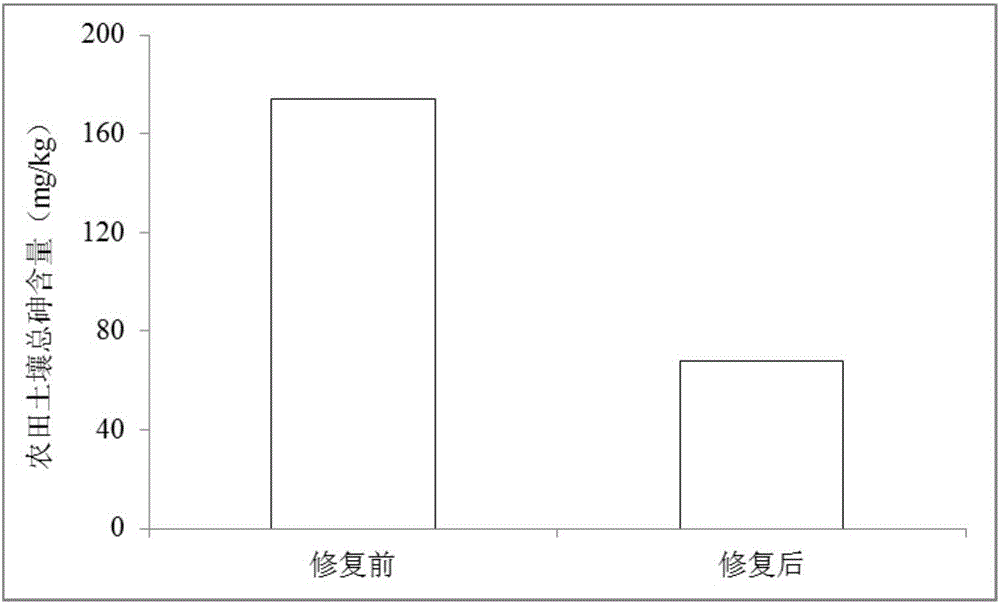In-situ remediation method for removing farmland soil arsenic
An in-situ restoration and farmland technology, applied in the restoration of contaminated soil, etc., can solve the problems that cannot fundamentally reduce the arsenic content in farmland soil, destroy the soil structure, reduce the arsenic activity, etc., and achieve large-scale promotion and simple operation , low-cost effect
- Summary
- Abstract
- Description
- Claims
- Application Information
AI Technical Summary
Problems solved by technology
Method used
Image
Examples
Embodiment 1
[0027] A 1.2-acre paddy field around a realgar mining area in Shimen, Hunan was selected, and soil samples were collected by the five-point method before treatment. The content of arsenic in soil samples was determined according to the heavy metal detection method specified in "Soil Environmental Quality Standards" (GB 15618-1995), and the total arsenic content was 654mg / kg. According to the leaching method specified in "Solid Waste Leaching Toxicity Leaching Method Sulfuric Acid Nitric Acid Method" (HJ / T299-2007), the method specified in "Standard Test Method for Drinking Water" (GB / T5750.6-2006) is used to measure pollution The content of arsenic ions in the soil leachate, the test result of arsenic leaching toxicity is 32.5mg / L. According to "Soil Testing Part 4: Determination of Soil Bulk Density" (NY / T1121.4-2006), the soil bulk density is 1.4g / cm 3 . The weight moisture content of the soil measured by drying method is 31.25%. The repair depth is 15cm. Magnetite powde...
Embodiment 2
[0029] According to the heavy metal detection method stipulated in the "Soil Environmental Quality Standard" (GB15618-1995), the content of arsenic in the soil sample was determined according to the heavy metal detection method stipulated in the "Soil Environmental Quality Standard" (GB15618-1995), and the total arsenic content was 349mg / kg. According to the leaching method specified in "Solid Waste Leaching Toxicity Leaching Method Sulfuric Acid Nitric Acid Method" (HJ / T299-2007), the method specified in "Standard Test Method for Drinking Water" (GB / T5750.6-2006) is used to measure pollution The content of arsenic ions in the soil leachate, the detection result of arsenic leaching toxicity is 8.9mg / L. According to "Soil Testing Part 4: Determination of Soil Bulk Density" (NY / T1121.4-2006), the soil bulk density is 1.32g / cm3 . The moisture content of soil weight measured by drying method is 35.80%. The repair depth is 20cm. Reduced iron powder (passed through a 120-mesh siev...
Embodiment 3
[0031] According to the heavy metal detection method stipulated in the "Soil Environmental Quality Standard" (GB15618-1995), the content of arsenic in the soil sample was determined according to the heavy metal detection method stipulated in the "Soil Environmental Quality Standard" (GB15618-1995), and the total arsenic content was 174mg / kg. According to the leaching method specified in "Solid Waste Leaching Toxicity Leaching Method Sulfuric Acid Nitric Acid Method" (HJ / T299-2007), the method specified in "Standard Test Method for Drinking Water" (GB / T5750.6-2006) is used to measure pollution The content of arsenic ions in the soil leachate, the detection result of arsenic leaching toxicity is 6.3mg / L. According to "Soil Testing Part 4: Determination of Soil Bulk Density" (NY / T1121.4-2006), the soil bulk density is 1.46g / cm 3 . The moisture content of soil weight measured by drying method is 29.52%. The repair depth is 17.5cm. Using carbonized rice husk to support nano-Fe ...
PUM
 Login to View More
Login to View More Abstract
Description
Claims
Application Information
 Login to View More
Login to View More - R&D
- Intellectual Property
- Life Sciences
- Materials
- Tech Scout
- Unparalleled Data Quality
- Higher Quality Content
- 60% Fewer Hallucinations
Browse by: Latest US Patents, China's latest patents, Technical Efficacy Thesaurus, Application Domain, Technology Topic, Popular Technical Reports.
© 2025 PatSnap. All rights reserved.Legal|Privacy policy|Modern Slavery Act Transparency Statement|Sitemap|About US| Contact US: help@patsnap.com



